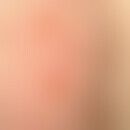Synonym(s)
Salt separation method; salt-split-skin; salt-split-skin method
DefinitionThis section has been translated automatically.
Separation of human skin by 24-48 hours incubation in hypertonic NaCl solution for subsequent indirect immunofluorescence.
General informationThis section has been translated automatically.
In this method, artificial cleavage is induced within the lamina lucida of the dermoepidermal junction zone by incubation with 1 molar NaCl solution. This examination facilitates the differential diagnosis of blistering dermatoses. In the case of pemphigoid, patient sera show a reaction of antibasal membrane antibodies with the epidermal part of the bladder (bladder cover), whereas in the case of epidermolysis bullosa acquisita a reaction with the dermal part (bladder floor) occurs. In 60-70% of patients with linear IgA dermatosis, IgA antibodies with reactivity against autoantigens in the epidermal region of the NaCL split skin can be detected. Patients with mucosal pemphigoid, show activity against autoantigens in the epidermal as well as in the dermal area in the laminin-5 (epiligrin)-reactive sera.
LiteratureThis section has been translated automatically.
- Gammon WR et al (1992) Immunofluorescence on split skin for the detection and differentiation of basement membrane zone autoantibodies. J Am Acad Dermatol 27: 79-87



